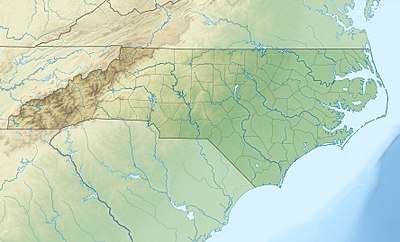Soul City, North Carolina
Soul City is a community in North Carolina, United States of America. It was a planned community first proposed in 1969 by Floyd McKissick,[1] a civil rights leader and director of the Congress of Racial Equality. Funded by the United States Department of Housing and Urban Development, (HUD) as one of thirteen model city projects under the Urban Growth and New Community Development Act, it was located on 5,000 acres (20 km2) in Warren County near Manson-Axtell Road and Soul City Boulevard in Norlina, North Carolina, 27563. According to McKissick, "Soul City was an idea before the movement. Soul City actually started after World War II, in my mind. And it was first talked about when we saw the use of the Marshall Plan, and all like that. See, I've always been in real estate and I've always been a businessman."[2][3]
Soul City, North Carolina | |
|---|---|
 Sign along Highway 158 marking the entrance to Soul City | |
 Soul City | |
| Coordinates: 36°24′31″N 78°16′13″W | |
| Country | |
| State | |
| County | Warren County |
| Established | 1969 |
| ZIP code | 27563 |

Soul City was intended to be a new town built from the ground up and open to all races, but placed emphasis on providing opportunities for minorities and the poor.[1][4] It was also designed to as a means of reversing out-migration of minorities and the poor to urban areas; the opportunities Soul City provided, such as jobs, education, housing, training, and other social services would help lessen the migration.[5]
The city was planned to contain three villages housing 18,000 people by 1989. Soul City was projected to have 24,000 jobs and 44,000 inhabitants by 2004.[5] It was intended to include industry and retail development for jobs, as well as residential housing and services. The plan was for residents to work, get schooling, shop, receive health care, and worship in town. Soul City was the first new town to be organized by African-American businesses. McKissick envisioned Soul City as a community where all races could live in harmony.[6]
In 1972, the city received a grant of $14 million from HUD based on plans of attracting industry as well as developing residential housing. 1972 Jesse Helms, a conservative, segregationist was elected to Congress. Helms saw Soul City as a misappropriation of federal funds. By 1974, pioneering families moved to Soul City and steady progress was apparent (laying of water and sewer lines, construction of roads, a day care center, a health care center, and early construction of ″Soul Tech I″ (the 52,000 foot squarespace of industrial space).[7]
In 1975 Soul City came under attack by two North Carolinians in Congress, Republican Senator Jesse Helms and Democrat Representative L.H. Fountain, who successfully pushed for an audit of Soul City, which Helms framed as an insult to the taxpayers.[8]
The city failed to reach its initial ambitions. Lawsuits and investigations into the use of funds by the Soul City Company, the city's developers, resulted in foreclosure in 1979 despite eventually being cleared by a Government Accountability Office audit. [9] In 1980, 35 housing units, a clinic, a tennis court, and a pool had been developed. About 150 people were employed in the city.
Since that time, the city has grown somewhat, but not to the size originally planned. The former Soultech 1 building was purchased by the adjoining Warren County Correctional Institution for expansion. A number of new homes have been constructed.
Representative Eva Clayton lived in and worked for Soul City Company before being appointed to a state position in community development, and later being elected to the United States Congress.
See also
References
- "North Carolina History Project : Soul City". Northcarolinahistory.org. Retrieved 2015-11-10.
- "Documenting the American South: Oral Histories of the American South." Interview by Jack Bass and Walter DeVries. Documenting the American South: Oral Histories of the American South. University of North Carolina at Chapel Hill, 6 Dec. 1973. Web. 06 Mar. 2013.
- "Documenting the American South: Oral Histories of the American South". Docsouth.unc.edu. Retrieved 2015-11-10.
- Schultz, Will. "Soul City." North Carolina History Project :. North Carolina History, n.d. Web. 09 Mar. 2013.
- McKissick, Floyd B. Soul City North Carolina. Soul City, NC, 1974. Print.
- Bey, Lee. "Story of cities #41: Soul City's failed bid to build a black-run suburbia for America". The Guardian. The Guardian. Retrieved 24 January 2017.
- Christopher Strain. 2004. “Soul City, North Carolina: Black Power, Utopia, and the African American Dream.” Journal of African American History.
- Carolyn M. Brown: Soul City
- "Information on the New Community of Soul City, North Carolina". www.gao.gov. 1975-12-18. Retrieved 2015-11-10.